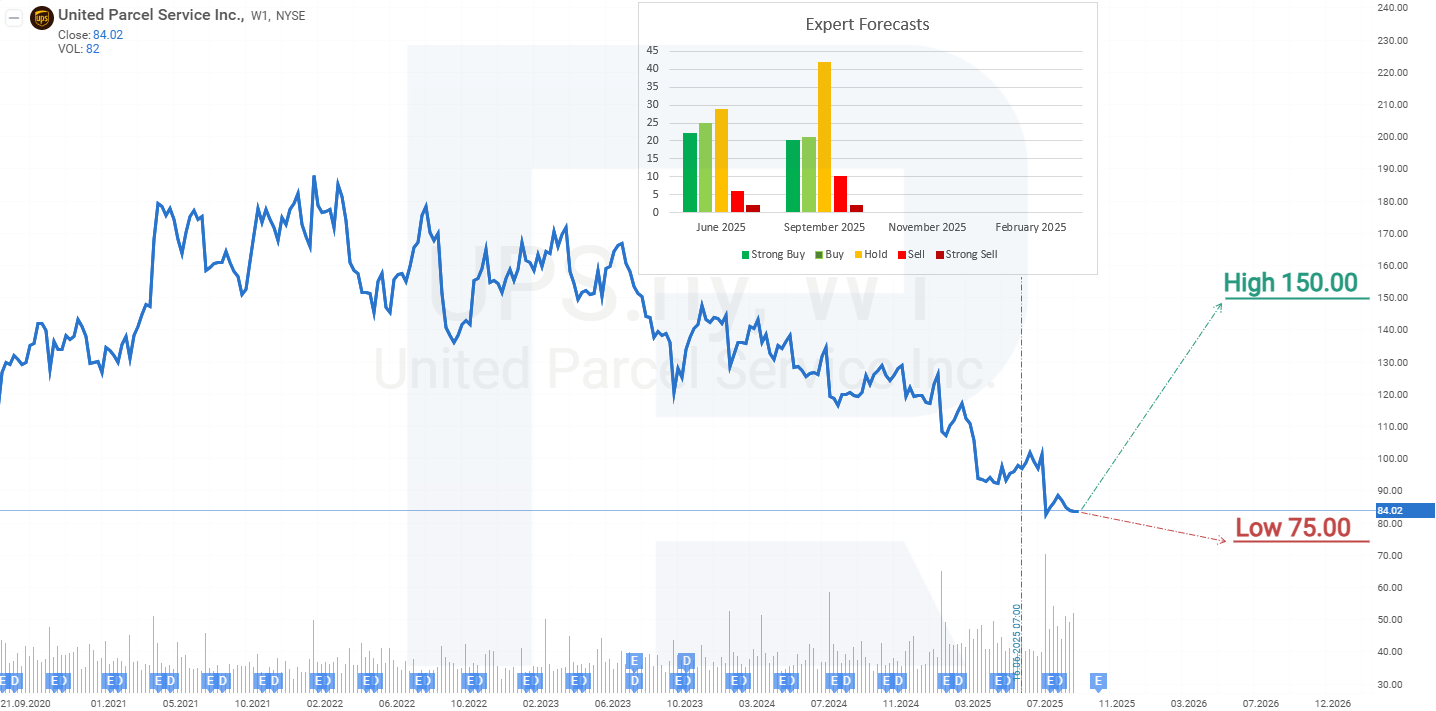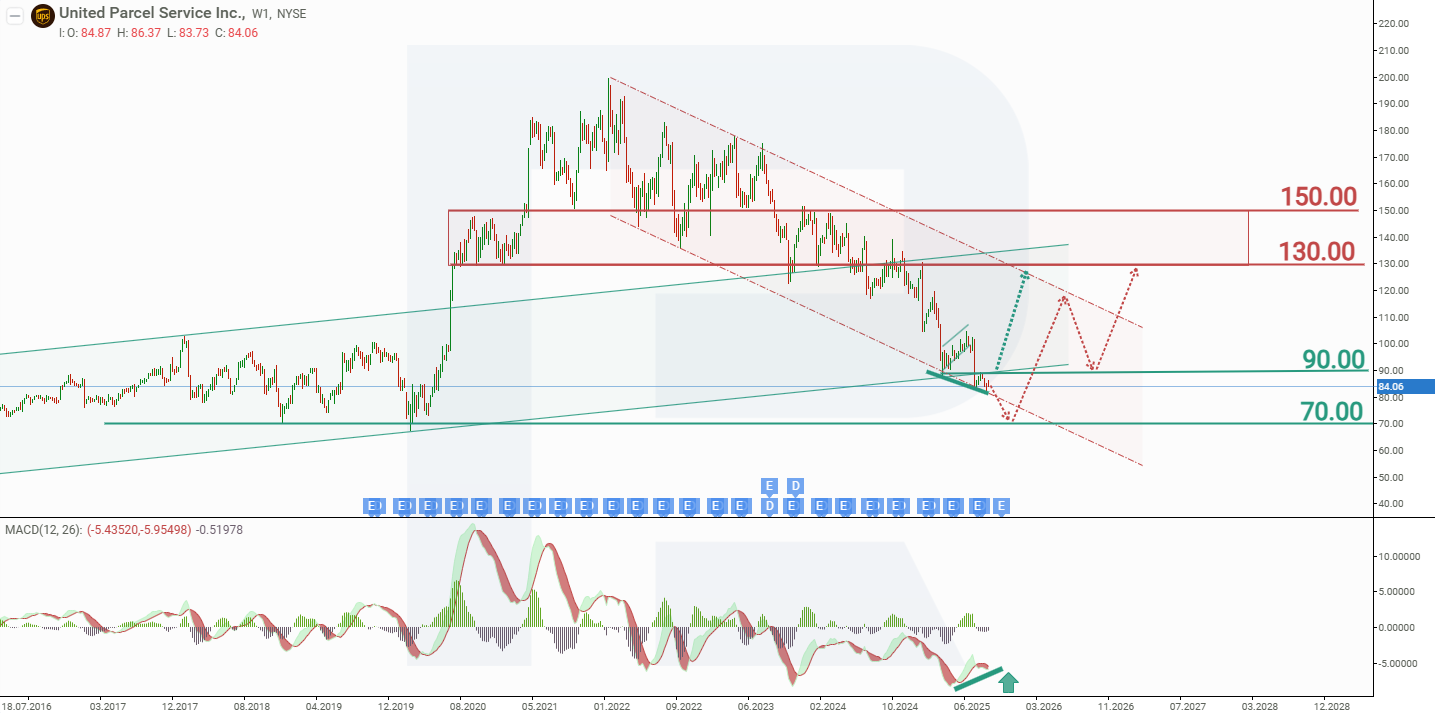UPS shares at their lowest: is it worth buying this dividend stock after a weak report?
Despite ongoing cost-cutting efforts, UPS is facing declining volumes in the US market, with tariff uncertainty adding to the pressure.
United Parcel Service (NYSE: UPS) reported Q2 FY2025 revenue of 21.2 billion USD, a non-GAAP operating margin of 8.8%, and non-GAAP EPS of 1.55 USD. Revenue exceeded analyst forecasts (20.87 billion USD), but earnings per share came in slightly below expectations (1.57 USD).
Weakness in the quarter’s financial performance was driven by lower volumes and higher delivery costs in the US, as well as a drop in revenue in the Supply Chain Solutions segment, mainly due to the sale of Coyote in 2024. The international business presented a brighter picture, with revenue up 2.6% to 4.49 billion USD and average daily volume up 3.9% year-on-year. Management reaffirmed its plan to achieve around 3.5 billion USD in cost savings in 2025. However, the company refrained from providing revenue and operating profit guidance, citing macroeconomic uncertainty and trade policy headwinds affecting cross-border flows. UPS also confirmed that it plans to pay dividends of approximately 5.5 billion USD and that it completed a 1 billion USD share buyback.
The market reacted very negatively to the report: the share price dropped nearly 10% immediately and continued to decline in the following days, hitting new annual lows. Investors focused less on the small miss against EPS forecasts and more on underlying issues such as declining domestic US volumes (especially in premium products) and a collapse in US–China corridor traffic, which directly impacted margins. Adding to the negative sentiment was the lack of updated full-year guidance, which market participants interpreted as a signal of high business uncertainty and management’s doubts about stabilisation in the second half. As a result, many investors and analysts revised their models downwards, increasingly viewing UPS as a dividend-oriented value stock with heightened risks of future payout cuts. This shift explains the sharp fall in market capitalisation.
This article examines United Parcel Service, Inc., outlines the sources of its revenue, reviews UPS’s performance in Q1 and Q2 FY2025, and sets out expectations for calendar 2025. It also provides a technical analysis of UPS shares, forming the basis for a UPS stock forecast for 2025.
About United Parcel Service, Inc.
United Parcel Service (UPS) is the world’s largest logistics and courier company, specialising in freight and parcel delivery as well as logistics solutions. Founded in Seattle, US, by James E. Casey and Claude Ryan in 1907 as the American Messenger Company, it was renamed United Parcel Service in 1919 as operations expanded beyond Seattle. Its initial public offering took place on 10 November 1999 on the New York Stock Exchange under the ticker UPS. The company provides express parcel delivery across the US and globally, along with international logistics, contract logistics, supply chain management, and specialised solutions for a range of industries, including e-commerce, healthcare, and manufacturing. It is headquartered in Atlanta, Georgia. UPS’ primary competitors include FedEx (NYSE: FDX) and DHL (XETR: DHL), part of the Deutsche Post Group, along with regional and local delivery operators, including national postal services and new market entrants such as Amazon Logistics.
Image of the company name United Parcel Service, Inc.United Parcel Service, Inc.’s business model
UPS’s business model is built around a wide range of logistics and transportation services. The company’s revenue is derived from the following key segments:
- US Domestic Package (domestic delivery across the US) : this is UPS’s primary revenue stream, comprising parcel delivery to individuals (B2C) and corporate clients (B2B) across the US. Revenue is generated through express delivery services, including UPS Next Day Air, as well as standard and economy options, with additional charges applied for overweight parcels, urgent shipments, and residential delivery
- International Package (international shipments) : this includes revenue from international parcel and freight deliveries worldwide, covering both export and import operations. UPS operates in over 220 countries, and the international division generates particularly high margins from the express delivery of documents and commercial shipments
- Supply Chain Solutions (logistics and supply chain operations) : this segment includes revenue from comprehensive logistics solutions, including contract logistics (warehousing, packaging, and inventory management), specialised solutions for healthcare, manufacturing, e-commerce and technology, LTL transportation services, ocean and air freight, as well as supply chain management and reverse logistics services
- Surcharges and Value-Added Services : this category includes fuel surcharges, peak load charges, insurance, tracking, rerouting, and other related services, which increase the average revenue per shipment
Thus, UPS generates revenue through a diversified portfolio of logistics services, serving both the mass segment (retail clients) and the large corporate sector with tailored supply chain solutions.
United Parcel Service, Inc. Q1 FY2025 report
On 23 April 2025, UPS published its results for Q1 fiscal 2025, which ended on 31 March 2025. Below is its key financial data compared to the corresponding period of last year:
- Revenue : 21.55 billion USD (–1%)
- Net income : 1.27 billion USD (+4%)
- Earnings per share : 1.49 USD (+4%)
- Operating margin : 8.20% (+20 basis points)
Revenue by segment:
- US Domestic Segment : 14.46 billion USD (+1%)
- Operating profit : 1.01 billion USD (+19%)
- International Segment : 4.37 billion USD (+3%)
- Operating profit : 654 million USD (–4%)
- Supply Chain Solutions : 2.71 billion USD (–15%)
- Operating profit : 98 million USD (–55%)
UPS’ Q1 fiscal 2025 report demonstrated the company’s agile adaptation to external challenges and its focused efforts to enhance operational efficiency and maintain profitability. With revenue down 1% to 21.5 billion USD, non-GAAP adjusted EPS was 1.49 USD, exceeding the consensus forecast by over 8%, confirming the stability of key business areas.
CEO Carol Tomé noted that UPS is undertaking the largest transformation of its logistics network in the company’s history, with plans to save 3.5 billion USD this year by closing 73 facilities and laying off 20,000 employees. This move enables the company to offset lower volumes, including a decline in orders from Amazon and tariff pressure on international shipments. UPS is adapting its structure to meet current demand, becoming more compact and efficient.
Although management did not update its full-year 2025 outlook due to macroeconomic uncertainty, particularly relating to tariffs, it provided guidance for Q2. Revenue is expected to reach 21 billion USD, with US parcel delivery volumes projected to decline by 9%. International margins are anticipated to remain in the mid-double-digit range (percentage terms). Margins in the US delivery segment are also forecast to rise by 30 basis points, supported by the impact of restructuring.
UPS is prioritising strict cost optimisation over revenue growth, and its Q2 guidance reflects a realistic, cautious stance amid ongoing uncertainty. If the company succeeds in implementing the planned 3.5 billion USD in savings, including potential further restructuring, it could emerge from the current cycle significantly more profitable and resilient.
United Parcel Service, Inc. Q2 FY2025 financial report
On 29 July 2025, UPS released its results for Q2 FY2025, which ended on 30 June 2025. The key financial metrics compared with the same period last year are as follows:
- Revenue : 21.22 billion USD (–3%)
- Net profit : 1.31 billion USD (–14%)
- Earnings per share : 1.55 USD (–13%)
- Operating margin : 8.80% (–60 basis points)
Revenue by segment:
- US Domestic Segment : 14.08 billion USD (–1%)
- Operating profit : 0.98 billion USD (–1%)
- International Segment : 4.49 billion USD (+3%)
- Operating profit : 682 million USD (–17%)
- Supply Chain Solutions : 2.65 billion USD (–18%)
- Operating profit : 212 million USD (–13%)
UPS reported Q2 FY2025 revenue of 21.2 billion USD and non-GAAP EPS of 1.55 USD. Sales exceeded analyst forecasts, but earnings came in slightly below consensus.
In the US, results were weaker: revenue declined, parcel volumes fell by 7%, and per-parcel delivery costs increased, weighing on margins. The international business presented the opposite picture: volume growth of nearly 4% and a profitability level of around 15% made this segment the strongest performer. The Supply Chain Solutions division was impacted by the sale of Coyote a year earlier, leading to lower revenue. Free cash flow for the first half of the year was 742 million USD – sufficient to cover dividends and investment, while the company continues to build resilience through cost savings.
The main weak spots for UPS are declining volumes in the US, rising per-parcel costs, and the lingering impact of the Coyote divestment. Additional pressure comes from new tariffs on low-value parcels from China, which are weighing on budget marketplaces and last-mile delivery.
On the positive side, UPS maintains high margins in its international segment and is firmly implementing its optimisation program, which is expected to deliver around 3.5 billion USD in cost savings in 2025. The company is also reducing reliance on Amazon, accepting lower volumes in exchange for improved profitability.
UPS does not provide quarterly guidance but reaffirmed its full-year 2025 plan – capital expenditure of around 3.5 billion USD, dividends of approximately 5.5 billion USD, and pension contributions of about 1.4 billion USD.
Fundamental analysis of United Parcel Service, Inc.
Below is the fundamental analysis of UPS following the Q2 FY2025 results:
- Liquidity and balance sheet : as of 30 June 2025, the company held 6.3 billion USD in cash and liquid assets against total debt of 24.7 billion USD, of which 0.9 billion USD is due within the year. Undrawn credit facilities of 3.0 billion USD also remain available. In 2025, eurobonds of around 700 million EUR are due for repayment, which management intends either to refinance or cover from its own funds. During the first half of the year, the company paid 460 million USD in interest, and at the current profit level, this leaves a substantial cushion for debt servicing. Overall, the metrics indicate comfortable short-term liquidity and a moderate debt burden
- Cash flow : in H1 FY2025, UPS generated operating cash flow of 2.67 billion USD with capital expenditure of 2.00 billion USD, resulting in free cash flow of around 670 million USD (or approximately 760 million USD, including 91 million USD from asset sales). Against this backdrop, the company has already allocated 2.70 billion USD to dividends and completed a 1.0 billion USD share buyback. The gap between relatively modest FCF and large distributions was covered by new borrowings: in H1, 4.15 billion USD of long-term debt was raised, offset by 1.06 billion USD in repayments, giving a net debt inflow of 3.09 billion USD. In effect, dividends and the buyback in 2025 are being financed by a mix of operating cash flow, existing funds and net new debt
- Dividends and coverage : at a share price of 84 USD, UPS’s dividend yield stands at around 7.7%, based on an annual dividend of roughly 6.52 USD – above the market average and a key factor supporting valuation. Management’s plan for FY2025 is a free cash flow of about 5.7 billion USD, which provides narrow but sufficient coverage of the dividend. If required, any temporary shortfall can be bridged by debt and working capital release in the second half of the year
- Debt : leverage remains manageable, with net debt of around 18.4 billion USD. EBITDA for H1 is estimated at 5.3 billion USD, which on an annualised basis equates to a Net Debt/EBITDA ratio of about 1.7. This level is considered moderate, while interest expenses are well covered by operating results, provided capital markets access remains intact
- Valuation of UPS shares : a P/E ratio in the 12–13 range, a dividend yield of about 7.7%, and a moderate debt level provide a basic layer of support for the share price, even amid weak demand. Upside potential is tied directly to the delivery of the 3.5 billion USD cost-saving program, stabilisation of volumes in H2, and the absence of new headwinds such as tariffs or pressure on low-margin parcel deliveries. Dividend coverage is expected to be tight but positive at the full-year FCF level, while buybacks have already been completed and are likely to remain secondary until cash flow improves. For conservative investors, it is reasonable to hold the stock or accumulate on dips if the dividend yield exceeds 8%
Conclusion of the fundamental analysis of UPS: the company’s financial position can be rated above average thanks to high liquidity and moderate leverage. However, dividend coverage from operating cash flow is marginal, and the buyback program for the year has been completed, effectively funded by borrowing. A share price of 84 USD looks justified if the cost-saving program is delivered and volumes stabilise in H2. If this program is not implemented, dividends will continue to be funded from the balance sheet, increasing the company’s sensitivity to interest rates and credit market conditions and placing further pressure on the UPS share price.
Expert forecasts for United Parcel Service, Inc. stock
- Barchart : 14 of 30 analysts rated UPS shares as Strong Buy, 1 as Moderate Buy, 12 as Hold, 1 as Sell, and 2 as Strong Sell. The upper end of forecasts is 133 USD, with the lower end at 75 USD
- MarketBeat : 11 of 29 analysts assigned a Buy rating, 15 recommended Hold, and 3 advised Sell. The upper end of forecasts is 150 USD, with the lower end at 75 USD
- TipRanks : 8 of 19 analysts rated the stock as Buy, 8 as Hold, and 3 as Sell. The upper end of forecasts is 133 USD, with the lower end at 75 USD
- Stock Analysis : 6 of 17 experts rated UPS shares as Strong Buy, 1 as Buy, 7 as Hold, and 3 as Sell. The upper end of forecasts is 147 USD, with the lower end at 75 USD
United Parcel Service, Inc. stock price forecast for 2025
On the weekly chart, UPS shares have been trading within a downward channel since early 2022 and have now reached the lower boundary, which acts as a support level. In addition, a convergence has formed on the MACD indicator, signalling the potential for an upward move in UPS’s share price. Based on the current performance of United Parcel Service shares, the two possible forecast scenarios for 2025 are as follows:
- Base forecast for UPS shares : this scenario assumes a breakout above resistance at around 90 USD, with a potential further rise towards the descending trendline at 130 USD. Realising this scenario may prove challenging, as UPS currently lacks a share buyback program, meaning demand must come entirely from investors. For this, a strong trigger would be needed – for example, unexpected positive news from the company or changes in tariff policy between the US and China that could support trade flows between the two countries
- Alternative forecast for UPS stock : this scenario assumes a decline towards support at around 70 USD, followed by a rebound and a move higher towards 130 USD. Should the share price fall to 70 USD, the annual dividend yield would be approximately 9.3% (assuming current payouts are maintained), which may attract long-term, income-oriented investors. This, in turn, could boost demand for UPS shares and act as a driver for further growth
Risks of investing in United Parcel Service, Inc.
stock
Investing in UPS stock entails several risks that may negatively impact its revenue and financial performance. The primary ones include:
- Economic cyclicality : demand for UPS logistics services is directly tied to overall economic activity. During recessions or periods of lower consumer demand, delivery and freight volumes decline, especially in the B2B and international trade segments
- Rising costs (particularly labour and fuel) : UPS is heavily reliant on labour and fuel. Rising diesel and aviation fuel prices and growing wages (among others, due to trade union contracts, for example, with the Teamsters) may significantly reduce operating margins
- Competition : the delivery market is becoming increasingly competitive. The major competitors – FedEx, DHL, Amazon Logistics, and national postal services – pursue aggressive pricing policies, invest in technology, and expand their infrastructure. Amazon, in particular, is actively developing its logistics, reducing its reliance on UPS as a contractor
- Technology and operational disruptions : delivery delays, IT system outages, cyberattacks, accidents, or inefficient management of the logistics chain may lead to losses, reputational risks, and customer attrition
- Seasonality and dependence on peak periods : a significant portion of annual revenue is generated during holiday periods, such as Q4. Any disruptions during this period, like adverse weather conditions, personnel shortages, or logistics delays, may cause a disproportionate impact
- Investment and capital expenditure : to remain competitive, UPS requires extensive modernisation of its fleet, IT infrastructure, and warehousing logistics. Mistakes in investment decisions or excessive capital intensity can reduce returns on invested capital
Thus, despite its status as the industry leader, UPS is subject to a variety of factors that may limit the company’s growth or reduce its financial resilience
Forecasts presented in this section only reflect the author’s private opinion and should not be considered as guidance for trading. RoboForex bears no responsibility for trading results based on trading recommendations described in these analytical reviews.




